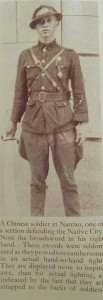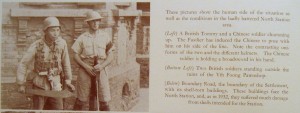The 1932 Shanghai War produced its share of heroes, since any war needs heroes, both for domestic and foreign consumption. I just found two stories of a Chinese hero known to his foreign admirers as “Charlie Chan.” Rhodes Farmer, an Australian reporter, mentioned him in his Shanghai Harvest: Three Years in the China War. He was “Shanghai’s most famous rooftop guerrilla, and the first Chinese hero produced by the foreign Press. This tatterdemalion soldier in a faded blue tunic and shorts that flapped far below his knees became the mascot of the British Tommies.” Charlie and his compatriots were not terribly articulate, since all he seemed to be able to say was “hello” and hun hun hao (very very good) when allowed to inspect a British Lee-Enfield rifle. He was, however, a master of urban guerrilla warfare, and supposedly ranged far beyond enemy lines, ambushing Japanese with his potato-masher grenades.1 In this version he killed over a hundred Japanese before they adopted the tactic of burning down entire blocks of buildings to get him.
The Americans also referred to a Chinese soldier who they called Charlie Chan, who manage to hold off a Japanese armored car with a machine gun and a collection of grenades. In this version he is a little more modern (he has a machine gun) and a tad more defined. The Americans thought he was a Communist, which I presume means he was from the 19th Route Army. He handles his machine-gun well, but does not actually kill anyone.
A much more interesting and articulate version of the same man turned up in the China Weekly Review. This is a much more sophisticated piece of propaganda. Here Charlie gets to speak for himself, (he gets a by-line) and explains that he is neither a Chan nor a Charlie, although he does not give his real name. He explains that
I am not a regular army man, but a plain citizen of Shanghai, employed in peaceful times by a local concern.
He was a member of the Shanghai Merchant Volunteer Corps, which had been founded after the Mukden Incident of 1931. In this version, as at the start of the Farmer story, he is in a strongpoint on the edge of the International Settlement. He and his comrades manage to drive off an assault by several Japanese armored cars. Much of the story makes him sound like a modern citizen-soldier, motivated by love of country and willing, like his comrades, to die for it. This Charlie does discuss his habit of exchanging greetings, with Farmer’s Tommies (who become Scots, Lincolnshires, and S.V.C. men in this version) and also with the U.S. 31st Division. Like Farmer he relates that they (starting with the Americans) tossed “Chesterfields, chocolates and candies” to him. He responded by tossing back some Japanese helmets, souvenirs of the battle in which the foreigners were not fighting. He also tossed them a tin of preserved bamboo shoots once, which caused quite a panic, as it might have been a bomb.
This Charlie is a much more modern Chinese. He is a skilled machine-gunner, far more aware of what is going on around him than in the other versions, and almost looks down at the foreign soldiers who are not fighting and who can’t tell harmless bamboo shoots from a grenade.
On the other hand, Charlie praises the Chinese Big Sword Corps. These were the Chinese soldiers armed with Big Swords 大刀 who first came to prominence in the Shanghai war
Here is how “Charlie” describes them.
I must explain about our Big Sword Corps, because it is not found in the modern army. It is a medieval force, employing primitive swords, such as you find in Roman history. Stripped to the waist, barefooted, these naked envoys of death swear never to return whenever they are sent forth. Armed with a huge sword, a pistol, and many hand grenades that hang around his waist, the Big Sword is a combination of modern and primitive soldier. His face is smeared with black grease, his hair is in disorder, and whenever he kills and enemy he puts his blood on his own face and body. His very sight is frightful even to his own men.
So we have a modern Chinese defending a modern nation, and a nation being defended by ancient and primitive techniques at the same time. I found this story because I am working on a paper on Chinese pilots and their role as symbols of a modern nation, but I may eventually see if I can dig up some more stuff on Charlie. For now, however, here is the story for your amusement. Actually, if you are teaching a Modern China class Charlie’s article might make a good primary source reading. You can find it on Pro-quest Fighting against Japan: From the China Weekly Review Shanghai American-Owned Weekly Chan, Charlie The Living Age (1897-1941); Jun 1932; 342, 4389; American Periodicals pg. 333
Update
Here are a couple of Big Sword pictures from the first months of the war. Both from Five Months of War Shanghai: North China Daily News, 1938. Both pictures suggest that the foreigners, at least, did not take Big Swords seriously as weapons.
p.68 ↩

